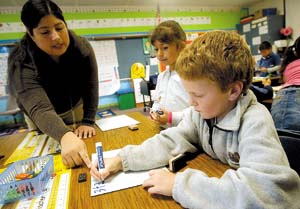The students are part of the Hollister Dual Language Academy at
Gabilan Hills School. In the academy
– one of the new magnet programs the Hollister School District
has launched – students do half of each day’s learning in Spanish
and half in English.
Hollister – In Carolina Gómez’s classroom, the first-grade students read their language arts books, their small fingers pointing at each word as they sound them out.
“¿Que es, Pepe?” the students read, as Gómez goes around to the tables, helping and complimenting the students – all in Spanish.
Next door, another group of first-graders also works on their language arts lesson, reading a similarly colorful book, in Deanna Cortez’s classroom.
“Nan can pat the fat, fat cat,” these students read, fingers tracing as they sound at the words. The students are complimented, corrected and taught all in English.
But just three hours earlier, these two groups of students were switched: Those reading Spanish were reading and learning in English, and those reading English were doing their lessons in Spanish.
The students are part of the Hollister Dual Language Academy at Gabilan Hills School. In the academy – one of the new magnet programs the Hollister School District has launched – students do half of each day’s learning in Spanish and half in English.
The 80 kids enrolled in the program – 40 first-graders and 40 kindergartners – come from English-speaking, Spanish-speaking or bilingual backgrounds. For some of the students, it’s been a steep learning curve adjusting to their teacher instructing them in a language they don’t understand for half the day.
“It’s been challenging but it’s been fun,” Gómez said. “Getting used to the switching is hard for the students.”
Julian Arreola, 6, grew up speaking Spanish and English. He said sometimes he still gets confused about specific words in Spanish, having attended kindergarten in English.
“When there’s so many words in Spanish, sometimes it’s hard,” Julian said, adding, “Sometimes I need help from my parents.”
But Julian also offers help – especially to the students coming from English-only language backgrounds during the Spanish half of the day.
Julian sometimes corrects and helps Georgia Wahl, 6, who sits across from him, with her Spanish.
“I know a little bit of Spanish,” Georgia said. “If someone says something, I know what to do.”
Georgia came from an English-only background, but had attended a bilingual kindergarten program. She explained that she can read words in Spanish but sometimes doesn’t understand what they mean. With the story the class read in their Language Arts lesson Wednesday, Georgia said she didn’t always understand what was going on, but knew she was learning a lot, anyway.
“I know that sopa means soup,” she said, gesturing to the book, which shows a picture of a bear slurping a spoon of soup from a bowl. “I’m learning the words.”
But, she said, she still can’t speak a lot of Spanish.
Still when Georgia raised her hand to ask her teacher a question, her Spanish sentences came out quickly and confidently.
Gómez, who is fluent in both English and Spanish, does not speak English ever in front of the kids.
“Then they’ll depend on it. This forces them to try to understand,” she said.
She uses hand gestures frequently to connote what she’s saying to the kids. If they truly don’t understand, she said, she will allow her students who speak Spanish to translate.
But now after a month in school, most of the kids understand a lot of what she says.
“They’re just immersed in it every day, so they catch on,” Gómez said.
Delia Gomez, the assistant principal at Gabilan Hills who heads the immersion program, said that so far – minus a few glitches – things have gone really well.
“The kids have adjusted so well, they’re really absorbing what they’re learning,” Gomez said. “We’re validating both languages.”
She said she goes into all four classrooms every day and it has been amazing watching the growth.
“The kids are actually writing in both languages and at the same time they’re understanding,” Delia Gomez said. “Our English speakers are writing in Spanish and vice versa.”
For Carolina Gómez, watching the students make leaps has been the most rewarding part of her job so far.
“When you find out from the parents that they’re speaking Spanish at home, or seeing the quiet students starting to participate and speak Spanish, it’s rewarding,” Gómez said.










